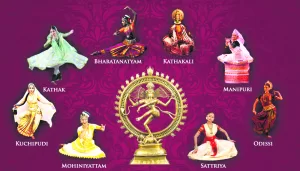Introduction
India has a rich and diverse cultural heritage, and classical dance forms play a significant role in preserving its traditions. For dancers, mastering these ancient art forms can be a deeply fulfilling journey. In this article, we’ll explore the Top 8 Classical Dance Forms in India that every dancer should know, their origins, styles, and the importance they hold in Indian culture.
1. Bharatanatyam – The Classical Dance of Tamil Nadu
Origin
Bharatanatyam traces its roots to Tamil Nadu, with its origins in the Natya Shastra, the ancient Indian treatise on performing arts. It was once performed in temples by Devadasis, showcasing devotion through dance.
Style
Bharatanatyam is known for its graceful yet powerful movements, complex footwork, expressive hand gestures (mudras), and facial expressions (abhinaya). It combines Nritta (pure dance), Nritya (expressive dance), and Natya (dramatic performance), all performed to the rhythm of a traditional Carnatic music ensemble.
Importance
Bharatanatyam is one of the oldest dance forms in India and remains one of the most popular. It’s often performed to convey religious stories and is revered for its spiritual significance.
2. Kathak – The Dance of Storytelling
Origin
Kathak originated in the northern parts of India, especially Uttar Pradesh. It was initially performed by traveling bards (Kathakars) who would narrate stories from the epics.
Style
Kathak is known for its fast spins (chakkars), graceful footwork, and expressive storytelling. The dance involves storytelling through intricate movements, where the dancer’s facial expressions play a key role in conveying the narrative.
Importance
Kathak bridges the gap between devotion and entertainment, combining elements of storytelling with technical virtuosity. It holds significance in both Hindu and Mughal traditions.
3. Odissi – The Sculptural Dance of Odisha
Origin
Odissi is from the state of Odisha and is one of the oldest surviving dance forms in India. It has strong ties to temple traditions, often performed as an offering to deities.
Style
Odissi is recognized for its graceful and fluid movements, characterized by the “tribhangi” pose (a three-bend stance). It is known for its lyrical expressions and intricate hand gestures (mudras) and often depicts episodes from Hindu mythology.
Importance
Odissi is revered for its devotion and beauty. It is performed primarily to express religious themes, but it also conveys complex narratives through rhythm and movement.
4. Kathakali – The Dance-Drama of Kerala
Origin
Kathakali comes from the state of Kerala in southern India and is known for its elaborate makeup, costumes, and storytelling. It blends drama, dance, and music, often drawing from Hindu epics like the Mahabharata and Ramayana.
Style
Kathakali performers use facial expressions, hand gestures, and dramatic movements to portray characters and emotions. The elaborate makeup and vibrant costumes enhance the dramatic effect, and the performances are accompanied by traditional music and singing.
Importance
Kathakali is a highly disciplined art form, involving years of rigorous training. It is a visual and emotional feast, telling ancient stories through highly stylized movements.
5. Manipuri – The Graceful Dance of Manipur
Origin
Manipuri dance comes from the northeastern state of Manipur and is often linked to rituals in temples and festivals. The dance is deeply connected to the Vaishnavism tradition, depicting stories from the life of Lord Krishna.
Style
Manipuri is characterized by its graceful and fluid movements, often performed in a circle or in a graceful flow. The dancers maintain an ethereal quality, with soft, circular movements and a focus on symmetry and balance.
Importance
Manipuri dance is noted for its spiritual and serene quality. It is considered one of the most delicate and refined classical dance forms, offering a deep connection to devotion and tradition.
6. Kuchipudi – The Dance of Andhra Pradesh
Origin
Kuchipudi originated in Andhra Pradesh and is a blend of dance and drama. Initially performed in temples, it later became a popular stage performance with a focus on theatrical expressions.
Style
Known for its quick footwork, expressive mudras, and dramatic facial expressions, Kuchipudi often tells stories of Hindu gods and goddesses through lively performances.
Importance
Kuchipudi is a dynamic dance form that combines both acting and dance. It is perfect for dancers who enjoy storytelling, energetic footwork, and dramatic expression.
7. Mohiniyattam – The Dance of the Enchantress
Origin
Mohiniyattam comes from Kerala and is associated with the mythical character Mohini, the female avatar of Lord Vishnu. It is a classical dance form that has its roots in the temples of Kerala.
Style
Known for its graceful, swaying movements, Mohiniyattam is often performed with subtle facial expressions and a focus on femininity. It is slower and more lyrical compared to other classical dances.
Importance
This dance form is ideal for those looking to master graceful, flowing movements with a focus on subtlety and femininity.
8. Sattriya – The Dance of Assam
Origin
Sattriya is a classical dance form from Assam, traditionally performed in the monasteries (Satras) of Assam. It combines both devotional and theatrical elements.
Style
Sattriya incorporates vibrant footwork, expressive hand gestures, and symbolic storytelling. It is deeply rooted in religious themes, often depicting the stories of Lord Krishna.
Importance
Sattriya is ideal for dancers interested in traditional, devotional dance forms. It offers a unique style with rich cultural storytelling, rhythmic footwork, and complex movements.
Conclusion: Embrace the Tradition, Master the Dance
The Top 8 Classical Dance Forms in India each offer unique perspectives on movement, expression, and storytelling. For dancers, learning these dance forms is not just about mastering technique; it’s about understanding the history, culture, and spirituality they represent. These art forms serve as a bridge to the rich cultural heritage of India, and mastering them is a journey of personal growth and artistic excellence.
Whether you’re an aspiring dancer or a seasoned performer, exploring these classical dance styles can help you appreciate the depth of Indian culture while honing your craft. Choose the one that resonates with you, and let the rhythm of tradition guide your performance.


Leave a Reply